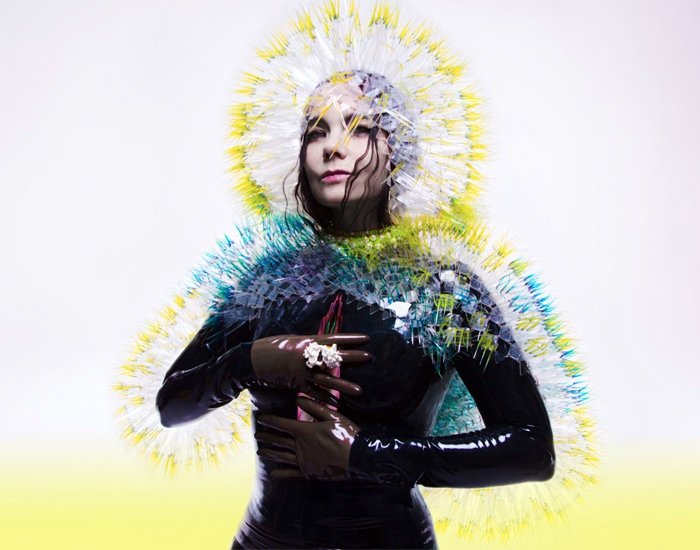In her latest album, Vulnicura, the Icelandic songstress wallows in despair and comes out of it…less depressed
Vulnicura is Björk’s journal, a chronicle of her breakup with longtime partner and father to her children Matthew Barney.
She describes her latest album as “teenage.” But unlike the regular Billboard Top 100 pop song, Björk’s resonates with a more mature audience.
For two decades, Björk has been a trailblazer, pioneering many musical techniques that had previously remained underground.
She has been credited as one of the first artists to incorporate electronic dance music in her 1993 album, very neatly titled Debut. Its 1995 follow up, Post, was more ambitious, experimenting with big band jazz while still rooted in EDM.
After her explosive entry into mainstream pop, she was hounded by the media, snagging a stalker who wanted to “change her life the most,” according to the ardent admirer.
Ricardo Lopez, obsessed with the singer, mailed her a bomb disguised as a book. Lopez documented this in a series of video tapes, culminating in a gruesome suicide where Lopez shot himself in the head. Fortunately for all of us, the bomb never made it to Björk.
The traumatic experience definitely changed Björk as Lopez intended. In 1997, she abandoned her cutesy persona and released Homogenic, a more mature album that cemented Björk’s legacy as a musical genius.
For the next decade, Björk would dabble in experimental music, like trip hop (a subgenre of hip-hop), even releasing an album made of grunts and vocalizations with her alienating album Medulla.
Her 2011 album, Biophilia, dealt with overarching themes such as man’s relationship with nature.
It was released as a series of apps, continuing Björk’s avant-garde tradition of art.
Her last album was ambitious and a disappointment to most critics. Some say Biophilia was an attempt to go back to pop, but that its jarring theme was overcooked.
Many expected Björk’s latest album, Vulnicura, to be another one of Björk’s art projects. But Björk always upends expectations.
Tortured genius
Vulnicura, a word invented by the artist, could have been derived from vulnerable and cure—two words that best describe the artist’s state of mind during the songwriting process.
“For people who have, unfortunately, gone through heartbreak, I think all of us would rather just skip it. But that’s not really an option. So you kind of just have to go through it to get to the other end,” she said in a podcast interview.
Like a journal, the album tackles her heartache chronologically.
In the album’s booklet, the first three songs lead up to the break up. Stonemilker is nine months before, Lionsong is five months before, and History of Touches is three months before. The next three tracks take place post-breakup.
“Moments of clarity are so rare, I better document this,” Björk sings in Stonemilker. Like many breakup songs, the lead up to separation is full of emotional confusion.
Vulnicura perfectly encapsulates the Kübler-Ross stages of grief. In History of Touches, the artist sings about the exact moment she realizes that love has ended.
“I wake you up in the night, feeling this is our last time together, therefore sensing all the moments we’ve been together,” she croons.
She reminisces about every moment she and her lover touched, but not fondly. She describes it as a wondrous time lapse, “every single archive compressed into a second.”
The relationship’s death is likened to a person’s life flashing before their eyes just moments before it ends.
Juxtaposition of sound
While people would not want to listen to 45 minutes of depressing music, consider this: Why are dramas in any medium so successful? The Greeks had a word for it. Catharsis.
To date, Vulnicura is Björk’s most personal album. On January 21, Björk announced her album’s availability on iTunes, months ahead of its intended release. The move to make it available was brought about by a leak.
To most artists, a leak means dismal future sales. But for Björk, the leak could be a good thing.
In the past, most of her albums were tied up in promotional gimmicks, overshadowing her artistry. This led to most critics chucking her work aside and labeling them novelties.
But the tortured Björk decided she no longer wants to wallow in despair. Getting the album out means she can move on both in her personal and professional life.
However, Vulnicura is not at a hurried break-up-and-move-on album. Björk wrote the lush string arrangement and choir parts, collaborating with Venezuelan producer Arca to come up with unique beats.
The complexity of Björk’s work harkens back to her beginnings two decades ago when she released Homogenic. Digital beats clash with syrupy strings—alienating to unfamiliar listeners, but a delight to fans of her body of work.
In Quicksand, the album’s last song, she sings: “When I’m broken I am whole, and when I’m whole I’m broken.”
It is unclear whether Björk has gotten through her ordeal when she sings hopeful lyrics to such angry melodies. As spectators, we can only wish that she has.
Vulnicura is now available in most formats.




